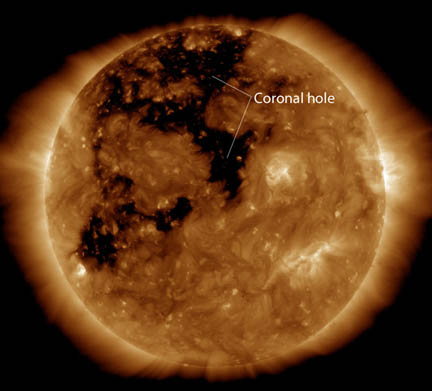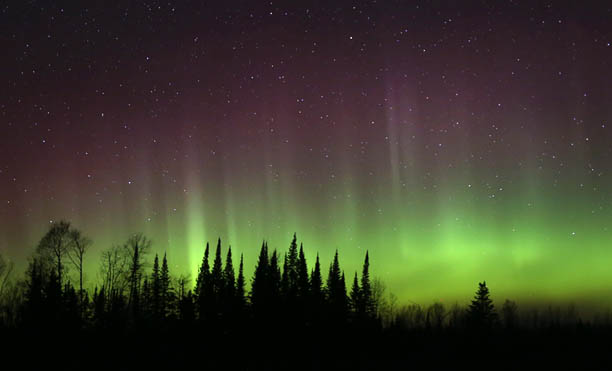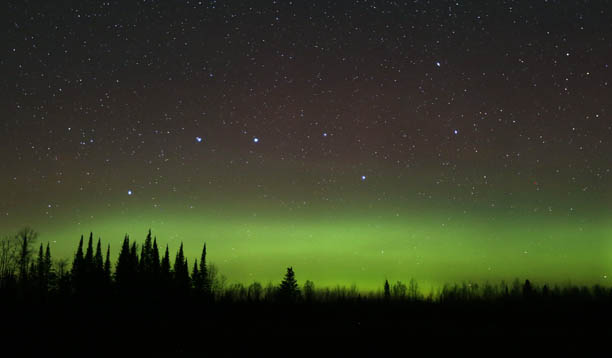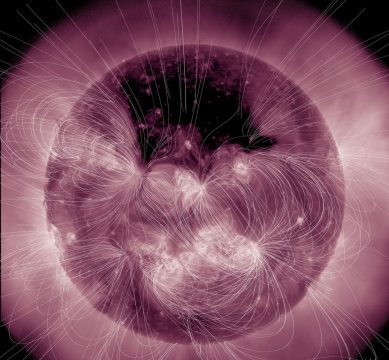Keep your eye on the northern sky. Auroras are in the forecast for the next couple nights courtesy of a "hole" in the Sun's corona.
| Update (October 25th): Since early this morning, a stronger than expected blast of solar wind has been ruffling Earth's magnetic field and stoking a strong geomagnetic storm. We're currently experiencing a G3 / Kp 7 event that's expected to last into mid-afternoon Eastern Time. Observers in northern Europe and Russia will likely witness an excellent display of northern lights. Their southern counterparts in New Zealand should also be on the lookout for the aurora australis. By the time darkness arrives in North America, the geomagnetic storm level is expected to drop to G2 / Kp 6 or moderate. Observers across the northern U.S. and southern Canada are urged to be on the lookout for aurora tonight. |

NASA / SDO
A hole in the Sun's corona has sparked what may turn into a 3-night-long show of northern lights. Auroras flared last night and are expected to fire up again tonight (October 24th) and strengthen further on Tuesday night.
Skywatchers who stayed up into the wee hours this morning were treated to a very nice show. Like many auroras, the display began with a greenish arc perched low over the northern horizon.
I viewed it from near Duluth, Minnesota, starting around 10 o'clock, but the aurora was also spotted from other northern U.S. and Canadian locations. For more than 2 hours, the recumbent arc quietly thickened, thinned, brightened and dimmed. Then at 12:30 a.m. today, it suddenly broke up into a froth of parallel streamers that stretched to 25° high.
According to NOAA's space weather forecast, after a lull this morning, the chances for more geomagnetic storming returns this afternoon U.S. time (night in Europe) and continues through the night into the early morning hours. Storms are rated on a scale from G1 to G5 with G1 being minor and G5 severe. G1 storms are visible from the northern parts of the U.S. from Maine, Michigan, Minnesota and points west. G2 or moderate storms can bring the aurora into view across the Midwest and northern mountain states. If you live in the southern half of the U.S. you likely will have to wait until levels hit G3 or higher.

Bob King
Storm levels relate to another measure of magnetic activity high in Earth's ionosphere called the Kp index, a measure of magnetic fluctuations in the Earth's ionosphere. When reading the forecast, Kp = 5 corresponds to a G1 storm, Kp = 6 to a G2 storm, and Kp = 7 to a storm of G3 or stronger.
We're expecting some G2 but mostly G1 storms this evening (October 24th), but that will ramp up to G2 by Tuesday evening, the 25th. With no Moon to light up the sky, viewing conditions are ideal. Regularly check the forecast link to see if conditions have changed.

Bob King
To view the aurora, find a location with a clear view to the north. The closer you can see down to the northern horizon the better. Auroral displays often begin with a long, low arc about 5° high spanning from northwest to northeast. When activity shoots up, the arc often breaks apart into rays which can brighten and reach all the way to the zenith — and beyond! — in strong displays.

NASA/SDO
This aurora is brought to you by a monster hole in the Sun's corona where the solar magnetic field and the particles embedded within it fly unrestrained into space. When they brush by Earth, those fields can reconnect with Earth's under the right conditions and send solar electrons and protons down along our planet's magnetic field lines into the upper atmosphere, where they can create auroras.
While solar weather can be unpredictable, here's hoping for a nice show the next couple of nights.
 4
4








